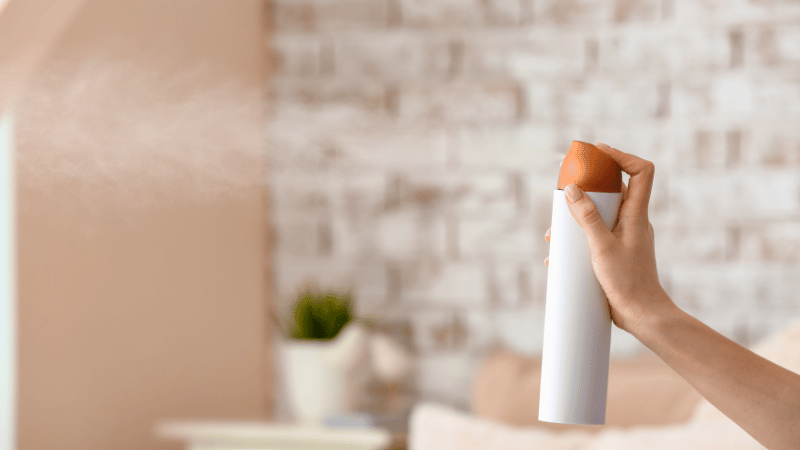Imagine stepping into a room filled with the delightful aroma of vanilla or lavender. It seems calming, inviting and like the perfect touch to make any space feel cozy. However, for some people, these pleasant scents can quickly turn into a headache—literally. As more of us strive to create welcoming environments in our homes and workplaces, the use of plug-ins, air fresheners, candles and essential oil diffusers has skyrocketed. The scented environment that was intended to be welcoming has become offensive and a place to be avoided for many. Not only are plug-ins, air-fresheners, candles and essential oils an extra cost but what other hidden costs are these fragrant additions causing to our health, especially for those with Multiple Chemical Sensitivities (MCS)? Let’s explore the potential health risks associated with common air fresheners and their impact on sensitive individuals.
The Allure of Scented Spaces
The market for scented products is vast, with everything from plug-in air fresheners to scented candles and essential oil diffusers promising to transform our indoor spaces into fragrant sanctuaries. The appeal is understandable: scents can evoke memories, influence moods, and even mask unpleasant odors. However, what we often overlook are the chemicals behind these appealing aromas.
Understanding Fragrance Sensitivity
Fragrance Sensitivity, also known as Fragrance Intolerance, is a condition where individuals experience adverse reactions to scented products. Symptoms can range from mild to severe and include headaches, dizziness, respiratory issues, skin irritation, and even asthma attacks. While not everyone is affected, those who are can find it challenging to avoid triggers, especially in environments where air fresheners are commonly used.
Understanding Multiple Chemical Sensitivity
Scented products may have a host of synthetic chemicals in them that can cause some people severe reactions, especially those with Multiple Chemical Sensitivity. Multiple Chemical Sensitivity is a condition where individuals experience a range of symptoms in response to exposure to various chemicals, often at levels that do not affect the general population. These chemicals can be found in everyday items like perfumes, cleaning products, pesticides, tobacco smoke, and even certain foods and building materials. Symptoms can be respiratory issues, headaches, fatigue, dizziness, cognitive issues, skin reactions, digestive issues, muscle and joint pain and etcetera.
The Hidden Risks of Common Air Fresheners
Volatile Organic Compounds (VOCs)
Many air fresheners release volatile organic compounds (VOCs) into the air. These chemicals can react with other airborne substances to form secondary pollutants, such as formaldehyde, which can be harmful to health. Prolonged exposure to VOCs can lead to respiratory issues, eye irritation, and even long-term health problems like liver or kidney damage.
Phthalates
Phthalates are chemicals used to prolong the duration of scents in air fresheners. They are known endocrine disruptors which means that they can interfere with the body’s hormonal systems. Exposure to phthalates has been linked to reproductive issues, developmental problems in children and increased risk of allergies and asthma.
Allergens
Many scented products contain allergens that can trigger allergic reactions in sensitive individuals. These allergens can be naturally occurring (such as essential oils) or synthetic. Reactions can range from mild skin rashes to severe respiratory distress, making it crucial to identify and avoid specific triggers.
The Impact on Indoor Air Quality
Indoor air quality is a significant concern, especially as we spend a considerable amount of our time indoors. The use of air fresheners can negatively impact this by introducing harmful chemicals into the air. Poor indoor air quality can exacerbate respiratory conditions, contribute to chronic illnesses and reduce overall well-being.
Essential Oils: Why Some May Want to Avoid Them
While essential oils are often marketed as natural alternatives to synthetic air fresheners, they are not without risks. Some individuals have allergic reactions to essential oils and it can irritate the respiratory system, especially in concentrated forms. To many people, essential oils can cause the same adverse health reactions as synthetic chemicals. Hence, why some people may want to avoid them.
Creating a Fragrance-Sensitive Friendly Environment
Choose Fragrance-Free Products
Opting for fragrance-free cleaning and personal care products is a simple yet effective way to reduce the risk of adverse reactions. Many brands now offer fragrance-free alternatives that are just as effective as their scented counterparts.
Improve Ventilation
Good ventilation can help disperse any harmful chemicals and improve overall air quality. Open windows when possible, use exhaust fans and consider investing in an air purifier with a HEPA filter to capture airborne particles.
Use Natural Alternatives
For those who still want to add a pleasant aroma to their space, consider natural alternatives. Fresh flowers, dried herbs, and spices can provide subtle, non-irritating scents. Simmering a pot of water with citrus peels, cinnamon sticks, or cloves can also fill your home with a delightful, natural fragrance. Remember, that, to some people, sometimes no smell is better than an added smell.
Educate and Communicate
If you manage a workplace, public space or rental, educate staff and visitors about Fragrance Sensitivity and Multiple Chemical Sensitivity. Set up the environment to be fragrance free and try to choose non-toxic products to avoid harsh, harmful chemicals. Implement a fragrance-free policy that can make these environments more inclusive and comfortable for everyone. Clear signage and communication can help ensure that everyone understands and respects these guidelines.
While plug-ins, air fresheners, candles and essential oil diffusers can enhance the ambiance of our indoor spaces, it’s essential to be aware of the potential health risks they pose, especially for those with Fragrance and Multiple Chemical Sensitivities. By choosing fragrance-free products, improving ventilation, choosing non-toxic products and exploring natural alternatives, we can create welcoming environments that are safe and comfortable for everyone. Remember, a truly inviting space is one that prioritizes the health and well-being of its occupants. So next time you reach for that air freshener, consider the invisible impact it might have and opt for a safer, healthier alternative.

